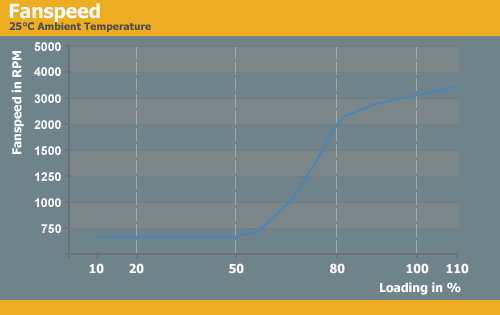Antec Signature 650W Power Supply
by Christoph Katzer on October 1, 2008 4:00 AM EST- Posted in
- Cases/Cooling/PSUs
Temperatures, Fan Speed, and Acoustics

Because of the low height of the installed heatsinks, they have a rather small volume. This means they hotter if they're not cooled correctly. The design of the Signature series is a bit different from other power supplies, so we can't directly compare the heatsink temperatures with other topologies. Regardless, larger heatsinks have a better chance to dissipate the heat. It's important to look at the difference between the heatsink temperatures and the exhausted air temperature, since this indicates whether the heatsinks are actually dissipating into the airflow effectively. The closer exhaust temperatures are to the heatsink temperatures, the better the heat dissipation. The Signature seems to have slight problems with dissipation, but it's nothing to worry about since the heatsinks only reached up to 80°C.

We have to admit that we haven't seen such a rapid increase in fan speed in such a short time before. The Signature stay very quiet up to 50% load, which is around 325W of power draw. After that, the fan quickly begins to spin much faster and reaches more than 3000 RPM at full load. That certainly isn't quiet anymore, with fan speeds similar to the PC Power & Cooling Turbo Cool 1200W.

As expected, the noise level increase matches the fan speed increase. The power supply is almost inaudible at only 17dB(A) all the way up to 350W of load, but then it gets louder fast and reaches its 33dB(A) zenith at full load and 10% overload. Of course, here we need to mention that with the provided connectors, users will have a difficult time reaching full load.










21 Comments
View All Comments
swaaye - Tuesday, October 28, 2008 - link
With regards to 80mm vs 120mm, I think that the best PSUs often have 80mm fans seems to say something.In the PSUs I've opened that have 120s, they are obviously restricted on component height inside. PSUs with 80mm fans are also designed around the air flowing from front to back, with heatsink cooling appropriately in-lined with the flow. A bottom 120mm isn't going to make airflow remotely as orderly.
I have used a mix of 80mm and 120mm units. Some 80mm units are as quiet as the quietest 120mm units, and some 120mm units are much louder than the 80mm units. Neither has an innate advantage with noise.
ducnow - Friday, October 3, 2008 - link
I would sooner have a small fan with a direct airflow with no restrictions front to back than a bottom 120mm fan under a poorly designed "quite" PSU that has poor airflow.The only thing I wish they would have done is made a single rail edition with more modular cables.
Another thing that sucks is that we just had a PSU make over in the last 4 years with the Nvidia cards using 8 pin on the GPU and higher end boards using a 6pin. I wonder if these will still be the standard when the new core i7 boards & the new Nvidia cards come out?
DTL - Thursday, October 2, 2008 - link
Why the Ambient Temperature only 25°C ? If you are not A big white bear lives near the North Pole.Your case always 40+°C and even 50°C for my case !!! Will there any testing condition down to the earth ?strikeback03 - Friday, October 3, 2008 - link
Then I'd say the airflow in your case could use improvement. No reason for internal temps to be over 40*C. My Centurion 5 internals are around 32-35*C (P965, E6600, Tuniq, 4GB, 2 320GB HDD, 7600GT)TravisChen - Saturday, October 4, 2008 - link
We have to set the standard near the worst case, not the optimal case. Quiet a few users have their CPU fan pumping hot air directly into the PSU so even your GFX and HDD are cool your PSU is not.strikeback03 - Monday, October 6, 2008 - link
My measurements were with a thermocouple inserted through a hole in the case, not on-board sensors.HOOfan 1 - Thursday, October 2, 2008 - link
Did you miss this?"we will keep the ambient temperature at 50°C in the stress test. "
HOOfan 1 - Thursday, October 2, 2008 - link
you consider 14.5mV a bit high? When the spec is all the way up at 50mV for 3.3V and 5V. 12V rails is "a bit lower" again, are you kidding? below 9mV when the spec is all the way up to 120mV.Really, are you trying your best to seem impartial since the Antec Signature ad is the top banner ad on this site?
bob4432 - Thursday, October 2, 2008 - link
would you guys compare this to the ea-650 to see what the extra ~$150 gets us?7Enigma - Thursday, October 2, 2008 - link
That's what I'd like to see as well. There is a DRASTIC difference in price between these 2 models, and my guess is the price does not fit the increase in quality/performance. But I need to know for sure. :)